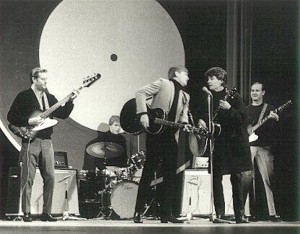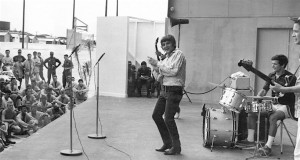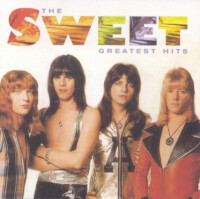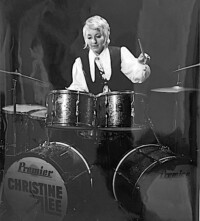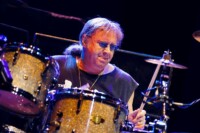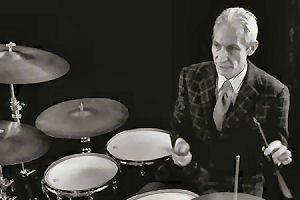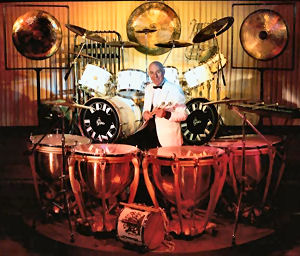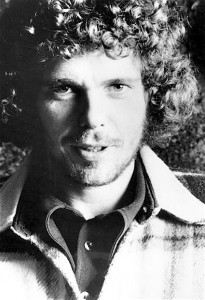 James Beck ‘Jim’ Gordon was born on July 14th, 1945, grew up in California’s San Fernando Valley and was educated at the same High School as Jeff Porcaro: Ulysses S, Grant. That said, since by my reckoning Jim is nine years older than Jeff, I doubt they could possibly have been there at the same time.
James Beck ‘Jim’ Gordon was born on July 14th, 1945, grew up in California’s San Fernando Valley and was educated at the same High School as Jeff Porcaro: Ulysses S, Grant. That said, since by my reckoning Jim is nine years older than Jeff, I doubt they could possibly have been there at the same time.
I met Jim in 1963 when he was in the UK with the Everly Brother’s backing group called ‘The Nashville Three’ at a time when I’d been playing with Adam Faith for a year or so. The gig I saw him at was the infamous one at the East Ham Granada at a time when Don Everly was having health problems and didn’t turn up for the show. It was saved by Joey Paige, the bass player, who took over the missing vocal, sang with Phil and made a pretty good fist of it. What I remember most about Jim was that he was 6’ 3” tall, played the Everly’s music exactly right (just like the records), had a wonderful Ludwig drum set (at a time when they weren’t available here), and used what seemed to be white drum sticks (at a time when ours in the UK were decidedly brown).
His awakening to drumming began, like so many others, by collecting himself a set of tin cans and canisters in the kitchen and bashing away on them. His folks must have recognised something in him and bought him some lessons – even though they wanted him to be a lawyer. He’d come home to Sherman Oaks from school and start practising the rudiments until bedtime – his favourite being the paradiddle which he confesses he used all through his playing career. These long bouts of practice ultimately made him realise what he wanted to do with his life, although in the beginning he harboured an ambition to be a music teacher. He actually was awarded a music scholarship to UCLA but declined the offer and immediately moved on to become a professional drummer.
He took piano lessons through all of his time at school and college which gave him a great grounding. When he was 15 he started playing in various clubs around LA, as well as doing the odd recording session. He enjoyed playing rock ‘n’ roll, although he also studied jazz so that he would be better rounded in the studios. Even though he liked jazz, he finally decided he was going to specialise in rock ‘n’ roll.
As I said, he backed The Everly Brothers with The Nashville Three, an outfit which comprised himself, Don Peake on guitar and Joey Paige on bass. This was his first proper paid gig (unless you count his time in the Burbank Symphony Orchestra where chances are he didn’t make too much money, even though he actually toured Europe with them one summer). At 16 years old he’d been paid peanuts when he played at weddings, Barmitvahs and clubs in a group called ‘Frankie Knight and the Jesters’ with the necessary help of a fake ID. He didn’t care though as he was happy to be playing. Surprisingly, the gig with the Everlys wasn’t particularly well-paid either but he was evidently able to go to college at the same time. The gig came about because Joey Paige spotted him playing in a Hollywood club and recommended him to Don and Phil. He joined them and they toured all over the Midwest as well as tours to the UK in ‘63 and ’64 when I saw him. When he came back from the UK he would do sessions and afterwards hang-out at the A & B Corned Beef Lounge with all the other session musicians taking a well-earned break before recording what could be another five songs in in three hours.
He was a proper percussionist and he’d had lessons at school from a percussionist named Bob Winslow which this stood him in good stead when he eventually started to break into the recording business. He admitted he wasn’t great at percussion but could always get by.
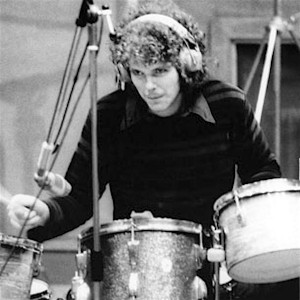 It was while he was recording with The Brothers Everly at Warner Brothers’ Studios that he started up friendships with Earl Palmer and Hal Blaine which greatly helped hi career. In ’63. ’64 and ’65 those guys were so busy they had more gigs than they could cope with and were happy to lay some of them off on somebody who could obviously handle them. He started out playing percussion in the studios: timpani, xylophone, vibes, tambourines, castanets and so on and was thrilled to find himself playing with Hal, Earl, Larry Bunker and Shelly Manne. He was delighted with this arrangement because he could get to see at close quarters what those guys were up to. Hal Blaine became extraordinarily busy, playing four sessions a day (and sometimes a full 28 a week) and passed on those he couldn’t physically get to in the direction of Jim Gordon.
It was while he was recording with The Brothers Everly at Warner Brothers’ Studios that he started up friendships with Earl Palmer and Hal Blaine which greatly helped hi career. In ’63. ’64 and ’65 those guys were so busy they had more gigs than they could cope with and were happy to lay some of them off on somebody who could obviously handle them. He started out playing percussion in the studios: timpani, xylophone, vibes, tambourines, castanets and so on and was thrilled to find himself playing with Hal, Earl, Larry Bunker and Shelly Manne. He was delighted with this arrangement because he could get to see at close quarters what those guys were up to. Hal Blaine became extraordinarily busy, playing four sessions a day (and sometimes a full 28 a week) and passed on those he couldn’t physically get to in the direction of Jim Gordon.
As I said he’d studied tuned percussion and freely admitted that while he wasn’t great he could get by. His reading was pretty good from the piano lessons and from having studied marimba in LA with a guy named Earl Hatz who taught him the 4-mallet technique with pieces from Mozart and Bach. Jim Horn, the sax player, assured him that percussion was the way to break into the recording business. In the fullness of time he became part of Hal Blaine’s ’Wrecking Crew’ playing two or three sessions a day, sometimes six or seven days a week. His reputation preceded him as: “The only living metronome” with a “knack for hitting the sweet spot”. Soon he was demanding (and receiving) ‘Triple scale’ for his work in the studios of LA and known as a “solid, reliable ‘pro’ session musician”.
When he began doing sessions there would sometimes be an arranger in the studio at the same time who would rewrite the parts as the arrangements changed, or the musicians would hear the tracks for the first time in the studio and write out their own parts. They could do four or five tracks in three hours. This could be music by The Beach Boys, Gary Puckett and Union Gap, or The Mamas and the Papas. Jim played on a great many albums but he really liked Gary Puckett’s records because they were what he called: ‘Big Band Rock ‘n’ Roll’ where everything was recorded live.
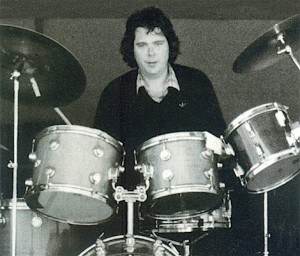 Jim played percussion on a lot of Phil Spector’s music like the Righteous Brothers and The Ronettes. As he tells it: the Sector ‘Wall Of Sound’ would often comprise six guitar players, three keyboard players, two drummers and five percussionists, who would all play a tune for five hours – live! Hal Blaine and Earl Palmer were often on these too. He played with Bobby Darin, Nancy Sinatra (are you ready boots?), Ann Margaret and Gordon Lightfoot (whose backing tracks were done in Toronto and the drums and percussion dubbed on in LA.
Jim played percussion on a lot of Phil Spector’s music like the Righteous Brothers and The Ronettes. As he tells it: the Sector ‘Wall Of Sound’ would often comprise six guitar players, three keyboard players, two drummers and five percussionists, who would all play a tune for five hours – live! Hal Blaine and Earl Palmer were often on these too. He played with Bobby Darin, Nancy Sinatra (are you ready boots?), Ann Margaret and Gordon Lightfoot (whose backing tracks were done in Toronto and the drums and percussion dubbed on in LA.
In his time Jim Gordon has certainly played with ‘Rock Royalty’. Among many others he’s added his support to are Ringo Starr, George Harrison, John Lennon, BB King, Harry Nilsson, The Mothers of Invention, Barbara Streisand, Joan Baez, Yoko Ono, Andy Williams, The Monkees, Thelma Houston, Crosby, Still, Nash and Young, Alice Cooper, Merle Haggard, Carole King, and Hall and Oates,
After seven years of constant studio work he was desperate to get on the road again. He’d seen a group in a club in LA called ‘Delaney and Bonnie and Friends’ and he really liked what they were doing. The band liked Jim Gordon too and Bonnie Bramlett had this to say of him: “he was sincere, considerate, brutally handsome, charming as a snake, and could he play! He was right on the money. I could do whatever I wanted. I was really enjoying myself. We all were and it showed. “
Delaney and Bonnie and Friends had a great many illustrious members although fortunately not all at the same time. Besides the name-sakes of the band, Duane and Gregg Allman, Leon Russell, Carl Raddle, Jim Price, Darrell Leonard, Dave Mason, Rita Coolidge, King Curtis, Bobby Whitlock, Jim Keltner, Bobby Keys, Gram Parsons and Eric Clapton were all members of it along with Jim Gordon.
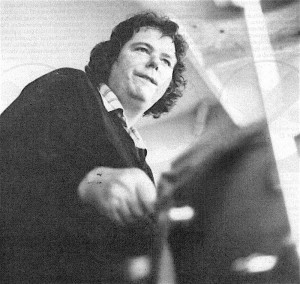 Clapton took Delaney and Bonnie and Friends on the road as support to ‘Blind Faith’ and he frequently sat in with them, preferring their music to Blind Faith’s! Eric Clapton continued with Delaney & Bonnie & Friends when Blind Faith eventually broke up.
Clapton took Delaney and Bonnie and Friends on the road as support to ‘Blind Faith’ and he frequently sat in with them, preferring their music to Blind Faith’s! Eric Clapton continued with Delaney & Bonnie & Friends when Blind Faith eventually broke up.
Jim stayed with them for 18 months on the road earning $125 a week before almost the whole band left to join Leon Russell in ‘Mad Dogs and Englishmen’ with Joe Cocker. Delaney and Bonnie were heartbroken.
Next he played on Derek and The Dominos’ album “Layla And Other Assorted Love Songs” in early 1970 and joined them on the road in the UK and the USA for a year or so. Things were beginning to go wrong by this time when his behaviour was being described as: “at best ambitious and manipulative, at worst violent”. This was the time when he knocked Rita Coolidge unconscious in a hotel corridor and returned to the rest of the band in another room as if nothing had happened.
He was very, very busy, somehow managing to tour with Joe Cocker’s ‘Mad Dogs and Englishmen’ and fitting in an album with Dave Mason, before going on the road with ‘Traffic’ and playing in Frank Zappa’s 20 piece Big Band: ‘The Grand Wazoo’ along with its 10 piece version called ‘Petit Wazoo’.
Steely Dan’s ‘Pretzel Logic’ and “Rikki Don’t Lose That Number” came along in ’74 in tandem with a two year stint with ex-Byrd Chris Hillman in the ‘Souther-Hillman-Furay Band’.
A list of records Jim Gordon has played on is extensive and if it’s alright with you I’ll leave you to provide the artists to go with just a few of the famous song titles –
Pet Sounds and Good Vibrations, Wichita Lineman, A Kind Of Hush and Solitaire, Rock The Boat, Beautiful Noise, Dream A Little Dream, It Never Rains In Southern California, You’re So Vain, All Things Must Pass, The Muppet Movie, Imagine, Pretzel Logic, Classical Gas and Layla. There are of course dozens more and it’s realistically claimed he played on at least 200 albums.
As far as the actual drums he played are concerned, as I said, when I saw him in 1963 with the Everlys he was playing a Ludwig and the photo of him with Joey Paige entertaining the troops in Vietnam shows what I assume is the same one up, one down silver glitter set with a Ludwig ‘400’ snare drum. This set was eventually followed by a natural maple Ludwig with 20” bass drums, 12 x 8, 13 x 9 and 14 x 14” toms. Eventually he had so many sessions in his diary that, like Hal Blaine he needed two drum sets although unlike Hal’s Monsters, they weren’t both designated ‘Number One’! Camco made him a couple of sets and he tried out the option of two 22” bass drums but gave up on the idea deciding that he was a simpler player than that. As far as cymbals are concerned it looks like he had two virtually identical sets both with 22” ride, 14” Paiste hi-hats, 15, 16, 17 and 18” Zildjian crashes and a Paiste China-type. For those who want the whole picture, he used Joe Calato’s ‘Regal tip’ 5B and 5A sticks.
Besides Jim Keltner, his all-time drumming heroes were Buddy Rich, Billy Cobham, Tommy Aldridge and Tony Williams.
There was a time when Jim Gordon was reportedly so busy as a studio musician that he would fly back to Los Angeles from Las Vegas every day to do two or three recording sessions and then return in time to play the evening show Caesar’s Palace.
Just about all the articles I’ve read about Jim Gordon start with the information I’m about to give you. I’m not interested in majoring on this because, while it’s important and obviously defines him as a person, it certainly doesn’t define him as a drummer. That particular facet/issue of course is what Groovers and Shakers is all about.
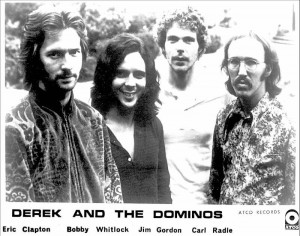 During his time with The Dominos, rumour has it they all became more and more involved with drink and a cocktail of drugs. Jim Gordon had a prodigious appetite for them and evidently a high tolerance too. Prior to this he’d never done anything stronger than grass but he took to all the other drugs available with a prodigious appetite. However, they had a profound psychological effect on his already fragile mind. He developed schizophrenia and began to hear voices in his head including his mother’s.
During his time with The Dominos, rumour has it they all became more and more involved with drink and a cocktail of drugs. Jim Gordon had a prodigious appetite for them and evidently a high tolerance too. Prior to this he’d never done anything stronger than grass but he took to all the other drugs available with a prodigious appetite. However, they had a profound psychological effect on his already fragile mind. He developed schizophrenia and began to hear voices in his head including his mother’s.
Jim Gordon had a personality disorder which was a major factor in the demise of Derek and the Dominoes. Unfortunately this illness was misdiagnosed and instead of his demons being taken care of, he was simply treated for alcohol abuse.
In 1983 these mood swings led to his conviction for murder. He had been hearing voices for quite some time which compelled him to behave in a certain way and stop eating, sleeping or relaxing. They even told him to stop drumming. On June 3 of that year under instruction from those voices, he drove to the Hollywood home of his 72 year old mother, attacked her with a hammer and then fatally stabbed her. He has been imprisoned ever since and been diagnosed schizophrenic, although it wasn’t until his trial in 1984 that it was properly detected. Because of a change of law in California, his attorney was unable to use the obvious defence of insanity. He was sentenced to 16 years to life in prison in 1984 – with little possibility of parole.
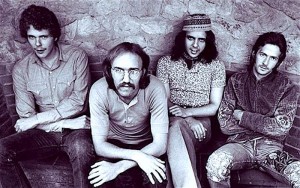 Jim Gordon has been described as ‘rock ‘n’ roll’s forgotten man’ except for one brief moment in 1993 when, along with Eric Clapton he received a Grammy as co-writer because of the evocative piano piece which comprises the coda end of ‘Layla’. I realise this copyright ownership has been disputed by Rita Coolidge and Bobby Whitlock but suffice it to say that the ownership of the song is attributed to Eric Clapton and Jim Gordon.
Jim Gordon has been described as ‘rock ‘n’ roll’s forgotten man’ except for one brief moment in 1993 when, along with Eric Clapton he received a Grammy as co-writer because of the evocative piano piece which comprises the coda end of ‘Layla’. I realise this copyright ownership has been disputed by Rita Coolidge and Bobby Whitlock but suffice it to say that the ownership of the song is attributed to Eric Clapton and Jim Gordon.
At the moment he’s incarcerated in the California Medical Facility at Vacaville which is halfway between San Diego and San Francisco. He’s applied for parole and was eligible after 17 years in jail but so far it’s been denied because psychiatrists don’t think he’s been rehabilitated and is still “seriously psychologically incapacitated”.
On reading back through this piece it becomes obvious that Jim Gordon seems to have done so much work over what I would say was a relatively short period of time, that it’s hardly surprising things went wrong for him.
Bob Henrit
August 2017

